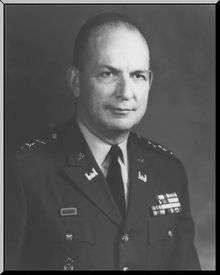Frederick J. Clarke
Frederick James Clarke (March 1, 1915 – February 4, 2002) was a civil and military engineer with the United States Army Corps of Engineers. Clarke was one of three commissioners appointed to run the District of Columbia from 1960 to 1963, and later rose to the rank of Chief of Engineers in the Corps of Engineers.
Frederick J. Clarke | |
|---|---|
 Lieutenant General Frederick J. Clarke | |
| Born | March 1, 1915 Little Falls, New York |
| Died | February 4, 2002 (aged 86) |
| Allegiance | United States of America |
| Service/ | United States Army |
| Years of service | 1937–1973 |
| Rank | Lieutenant General |
| Commands held | Chief of Engineers (1969–1973) |
| Awards | Distinguished Service Medal Legion of Merit |
Clarke was born in Little Falls, New York. In 1937 he graduated fourth in his class at the United States Military Academy at West Point, New York. He was then commissioned in the Corps of Engineers, while continuing his graduate work. Clarke received a master's degree in civil engineering from Cornell University in 1940 and later attended the six-week Advanced Management Program at Harvard Business School. He also completed graduate studies at the Army War College.
During World War II he commanded a battalion of the 38th Combat Engineers that helped construct a military airfield on Ascension Island in the South Atlantic, a key refueling point for transatlantic flights to Africa. He also served in Washington, D.C., in the headquarters of the Army Service Forces. He served as a logistics planner on General George C. Marshall's staff. He also was an early developer of the "Red Ball Express" operation that kept European beachheads supplied.
As the war in Europe ended, he was involved in the frenzied planning effort to redirect supplies to the Pacific. Clarke also worked in the atomic energy field for the Manhattan Engineer District (best known as the Manhattan Project).
After the war his atomic work continued, with the U.S. Atomic Energy Commission at Hanford, Washington, and at the Armed Forces Special Weapons Project at Sandia Laboratory, Albuquerque, New Mexico. As the District Engineer of the Trans-East District of the Corps in 1957-59, he was responsible for U.S. military construction in Pakistan and Saudi Arabia, and he initiated transportation surveys in East Pakistan and Burma.
From 1874 to 1967, before "District of Columbia home rule," the District was governed by three federally appointed commissioners (one a civil engineer, selected from the Army Corps of Engineers). In 1960, President Dwight D. Eisenhower appointed Clarke as the District's Engineer Commissioner. He was the technician-in-chief, called to address the problems such as traffic gridlock, economic development and low levels of funding. At one point early in his term, he was the only commissioner available for full-time duty, because one post was vacant and the other commissioner had suffered a heart attack.
In the early 1960s, Clarke participated in talks that led to the compact agreement for construction of the Washington Metro railway and subway system. As chairman of the District's zoning commission, he participated in early debates over the controversial proposal to build an interstate bridge near the Three Sisters Islands in the Potomac River, and over a planned freeway through the heart of the District.
After his term as Engineer Commissioner ended in 1963, he served as Director of Military Construction in the Office of the Chief of Engineers (1963–65); Commanding General of the Army Engineer Center and Fort Belvoir and Commandant of the Army Engineer School (1965–66); and Deputy Chief of Engineers (1966–69). He achieved the rank of Lieutenant General. As Chief of Engineers Clarke guided the Corps as it devoted increased attention to the environmental impact of its work.
He retired from the Army in 1973 after a 37-year career, then served as executive director of the National Commission on Water Quality. In the 1980s, he was a consultant to the Tippetts, Abbett, McCarthy, Stratton engineering firm.
After his death in 2002, he was buried in Arlington National Cemetery.[1]
Clarke was awarded the Distinguished Service Medal and the Legion of Merit. In 1973 he was elected to the National Academy of Engineering.[2]
Notes
References
- This article contains public domain text from "Lieutenant General Frederick J. Clarke". Portraits and Profiles of Chief Engineers. Archived from the original on June 19, 2005. Retrieved August 22, 2005.
| Military offices | ||
|---|---|---|
| Preceded by William F. Cassidy |
Chief of Engineers 1969—1973 |
Succeeded by William C. Gribble, Jr. |